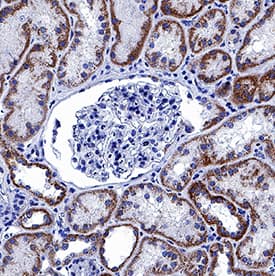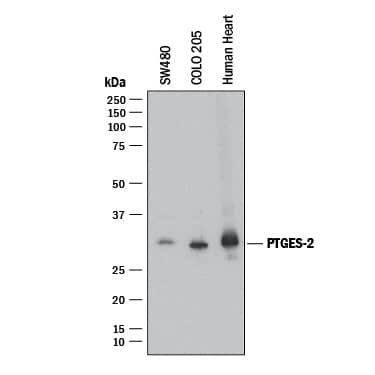Human Prostaglandin E Synthase 2/PTGES2 Antibody
R&D Systems, part of Bio-Techne | Catalog # MAB7627

Key Product Details
Species Reactivity
Human
Applications
Immunohistochemistry, Western Blot
Label
Unconjugated
Antibody Source
Monoclonal Mouse IgG2A Clone # 998012
Product Specifications
Immunogen
E. coli-derived recombinant Human Prostaglandin E Synthase 2/PTGES2
Glu88-His377
Accession # Q9H7Z7
Glu88-His377
Accession # Q9H7Z7
Specificity
Detects Human Prostaglandin E Synthase 2/PTGES2 in direct ELISAs.
Clonality
Monoclonal
Host
Mouse
Isotype
IgG2A
Scientific Data Images for Human Prostaglandin E Synthase 2/PTGES2 Antibody
Detection of Human Prostaglandin E Synthase 2/PTGES2 by Western Blot.
Western blot shows lysates of SW480 human colorectal adenocarcinoma cell line, COLO 205 human colorectal adenocarcinoma cell line, and human heart tissue. PVDF membrane was probed with 2 µg/mL of Mouse Anti-Human Prostaglandin E Synthase 2/PTGES2 Monoclonal Antibody (Catalog # MAB7627) followed by HRP-conjugated Anti-Mouse IgG Secondary Antibody (Catalog # HAF018). A specific band was detected for Prostaglandin E Synthase 2/PTGES2 at approximately 30 kDa (as indicated). This experiment was conducted under reducing conditions and using Immunoblot Buffer Group 1.Prostaglandin E Synthase 2/PTGES2 in Human Kidney.
Prostaglandin E Synthase 2/PTGES2 was detected in immersion fixed paraffin-embedded sections of human kidney using Mouse Anti-Human Prostaglandin E Synthase 2/PTGES2 Monoclonal Antibody (Catalog # MAB7627) at 5 µg/mL for 1 hour at room temperature followed by incubation with the Anti-Mouse IgG VisUCyte™ HRP Polymer Antibody (Catalog # VC001). Before incubation with the primary antibody, tissue was subjected to heat-induced epitope retrieval using Antigen Retrieval Reagent-Basic (Catalog # CTS013). Tissue was stained using DAB (brown) and counterstained with hematoxylin (blue). Specific staining was localized to cytoplasm in epithelial cells in convoluted tubules. View our protocol for IHC Staining with VisUCyte HRP Polymer Detection Reagents.Applications for Human Prostaglandin E Synthase 2/PTGES2 Antibody
Application
Recommended Usage
Immunohistochemistry
5-25 µg/mL
Sample: Immersion fixed paraffin-embedded sections of human kidney
Sample: Immersion fixed paraffin-embedded sections of human kidney
Western Blot
2 µg/mL
Sample: SW480 human colorectal adenocarcinoma cell line, COLO 205 human colorectal adenocarcinoma cell line, and Human heart tissue
Sample: SW480 human colorectal adenocarcinoma cell line, COLO 205 human colorectal adenocarcinoma cell line, and Human heart tissue
Formulation, Preparation, and Storage
Purification
Protein A or G purified from cell culture supernatant
Reconstitution
Reconstitute at 0.5 mg/mL in sterile PBS. For liquid material, refer to CoA for concentration.
Formulation
Lyophilized from a 0.2 μm filtered solution in PBS with Trehalose. *Small pack size (SP) is supplied either lyophilized or as a 0.2 µm filtered solution in PBS.
Shipping
Lyophilized product is shipped at ambient temperature. Liquid small pack size (-SP) is shipped with polar packs. Upon receipt, store immediately at the temperature recommended below.
Stability & Storage
Use a manual defrost freezer and avoid repeated freeze-thaw cycles.
- 12 months from date of receipt, -20 to -70 °C as supplied.
- 1 month, 2 to 8 °C under sterile conditions after reconstitution.
- 6 months, -20 to -70 °C under sterile conditions after reconstitution.
Background: Prostaglandin E Synthase 2/PTGES2
Alternate Names
C9orf15, GBF1, mPGES2, PGES2
Gene Symbol
PTGES2
UniProt
Additional Prostaglandin E Synthase 2/PTGES2 Products
Product Documents for Human Prostaglandin E Synthase 2/PTGES2 Antibody
Product Specific Notices for Human Prostaglandin E Synthase 2/PTGES2 Antibody
For research use only
